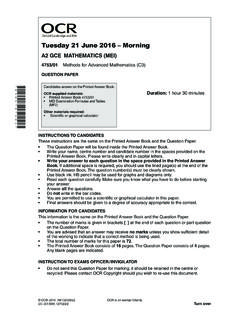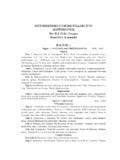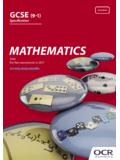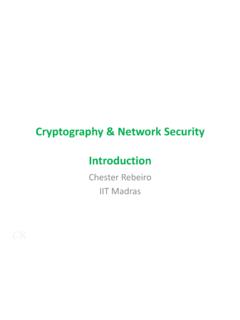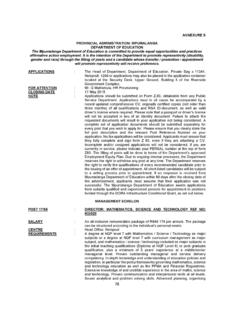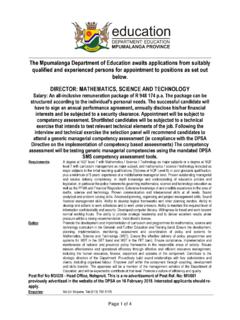Transcription of The Mathematics of the RSA Public-Key …
1 The Mathematics of the RSA Public-Key Cryptosystem Burt Kaliski RSA Laboratories ABOUT THE AUTHOR: Dr Burt Kaliski is a computer scientist whose involvement with the security industry has been through the company that Ronald Rivest, Adi Shamir and Leonard Adleman started in 1982 to commercialize the RSA encryption algorithm that they had invented. At the time, Kaliski had just started his undergraduate degree at MIT. Professor Rivest was the advisor of his bachelor s, master s and doctoral theses, all of which were about cryptography. When Kaliski finished his graduate work, Rivest asked him to consider joining the company, then called RSA Data Security. In 1989, he became employed as the company s first full-time scientist. He is currently chief scientist at RSA Laboratories and vice president of research for RSA Security. Introduction Number theory may be one of the purest branches of Mathematics , but it has turned out to be one of the most useful when it comes to computer security.
2 For instance, number theory helps to protect sensitive data such as credit card numbers when you shop online. This is the result of some remarkable Mathematics research from the 1970s that is now being applied worldwide. Sensitive data exchanged between a user and a Web site needs to be encrypted to prevent it from being disclosed to or modified by unauthorized parties. The encryption must be done in such a way that decryption is only possible with knowledge of a secret decryption key. The decryption key should only be known by authorized parties. In traditional cryptography, such as was available prior to the 1970s, the encryption and decryption operations are performed with the same key. This means that the party encrypting the data and the party decrypting it need to share the same decryption key. Establishing a shared key between the parties is an interesting challenge. If two parties already share a secret key, they could easily distribute new keys to each other by encrypting them with prior keys.
3 But if they don t already share a secret key, how do they establish the first one? This challenge is relevant to the protection of sensitive data on the Web and many other applications like it. Your computer doesn t initially share any secret keys with Web sites. How then do you encrypt data you are sending to the site? You might eventually set up a password, and the password could then be used to derive an encryption key. But how do you protect the password from interception when you re first setting it up? THE Mathematics OF THE RSA Public-Key CRYPTOSYSTEM Page 2 This line of thinking in pre-Web terminology prompted two Stanford University researchers, Whitfield Diffie and Martin Hellman, to write a landmark paper, New Directions in Cryptography, in 1976. The paper suggested that perhaps encryption and decryption could be done with a pair of different keys rather than with the same key. The decryption key would still have to be kept secret, but the encryption key could be made public without compromising the security of the decryption key.
4 This concept was called Public-Key cryptography because of the fact that the encryption key could be made known to anyone. Diffie and Hellman s approach immediately answered the setup problems for protecting online data. To enable computers to encrypt data for a site, the site simply needs to publish its encryption key, for instance in a directory. Every computer can use that encryption key to protect data sent to the site. But only the site has the corresponding decryption key, so only it can decrypt the data. Diffie and Hellman also introduced the concept of digital signatures. Parties who share a secret key can easily verify that data they exchange has not been modified by performing an authentication operation using the key. But what if they don t share a key? For this problem, Diffie and Hellman suggested another application of Public-Key cryptography, but with the order of encryption and decryption reversed. To protect the data it sends from modification, a site would first decrypt the data with its private decryption key.
5 The computer receiving the result would encrypt it with the corresponding encryption key, and thereby recover and verify the data. The result is called a digital signature because it has similar properties to handwritten signatures: Any computer can verify the signature, but only the originating site can generate it. In fact the assurances are stronger than for ordinary signatures, because the signature is dependent on the data itself, unlike ordinary signatures which can potentially be cut-and-pasted among different documents and yet still appear to be valid. Digital signatures help with the next question in Public-Key cryptography: If a site publishes its encryption key in a directory, how do I know that the data in the directory is authentic? Answer: The directory digitally signs the data with its private key. All the computer needs to have in advance is the directory s public key for verifying the directory s signature. (This concept is implemented today in digital certificates.)
6 The computer can then verify the encryption key for any site. Diffie and Hellman didn t identify a method with the full Public-Key encryption/decryption properties that would also enable digital signatures. However, they did introduce a specific method based on number theory for establishing secret keys by parties who don t previously share a secret. The method, called Diffie-Hellman key agreement, is still in use today. The security of the method is related to a longstanding problem in number theory, discrete logarithms. The full Public-Key method would come a year later as an application of another famous problem, integer factorization. THE Mathematics OF THE RSA Public-Key CRYPTOSYSTEM Page 3 Prime Generation and Integer Factorization Two basic facts and one conjecture in number theory prepare the way for today s RSA Public-Key cryptosystem. FACT 1. Prime generation is easy: It s easy to find a random prime number of a given size.
7 This is a result of two other points: Prime numbers of any size are very common, and it s easy to test whether a number is a prime even a large prime. To generate a random prime, one can simply generate random numbers of a given size and test them for primality until a prime is found. According to the Prime Number Theorem, the expected number of candidates to test will be on the order of ln x (the natural logarithm of x) where x is a typical number of the intended size. It hasn t always been easy to test whether a number is a prime. In fact, it might seem that testing for primality would require one to determine all the factors of the number to see if there are others beside the number itself and 1. Faster methods for primality testing were discovered in the 1970s that test for certain properties held by prime numbers but not by composites, rather than finding the factors. Without these results, much of Public-Key cryptography today would not be practical because of the dependence on efficient methods of generating primes.
8 In the following, let p and q be two large, randomly generated primes. Large in the cryptographic context typically means 512 bits (155 decimal digits) or more. FACT 2. Multiplication is easy: Given p and q, it s easy to find their product, n = pq. There are many efficient ways to multiply two large numbers, starting with the grade-school method that multiplies one number by the other digit-by-digit, and sums the tableau of intermediate results. CONJECTURE 3. Factoring is hard: Given such an n, it appears to be quite hard to recover the prime factors p and q. Despite hundreds of years of study of the problem, finding the factors of a large number still takes a long time in general. The fastest current methods are much faster than the simple approach of trying all possible factors one at a time. (Such a method would take on the order of n steps.) However, they are still expensive. For instance, it has been estimated recently that recovering the prime factors of a 1024-bit number would take a year on a machine costing US $10 million.
9 A 2048-bit number would require several billion times more work. These estimates are much less than would have been expected in the 1970s when the problem was first proposed in cryptography. The recommended sizes have accordingly THE Mathematics OF THE RSA Public-Key CRYPTOSYSTEM Page 4 increased over the years, due to the discovery of faster factoring methods as well as steady advances in computing power. No one knows whether still faster methods might be discovered in the coming years. On the other hand, no one has proved that they can t be. Both aspects remain important research areas in Mathematics . Modular Exponentiation and Roots Given this background, n will hereafter denote the product of two large, randomly generated primes. Let m and c be integers between 0 and n-1, and let e be an odd integer between 3 and n-1 that is relatively prime to p-1 and q-1. The encryption and decryption operations in the RSA Public-Key cryptosystem are based on two more facts and one more conjecture: FACT 4.
10 Modular exponentiation is easy: Given n, m, and e, it s easy to compute c = me mod n. The value me mod n is formally the result of multiplying e copies of m, dividing by n, and keeping the remainder. This may seem to be an expensive computation, involving e-1 multiplications by m with increasingly large intermediate results, followed by a division by n. However, two optimizations make the operation easy: 1. Multiplying by an appropriate sequence of previous intermediate values, rather than only by m, can reduce the number of multiplications to no more than twice the size of e in binary. 2. Dividing and taking the remainder after each multiplication keeps the intermediate results the same size as n. FACT 5. Modular root extraction the reverse of modular exponentiation is easy given the prime factors: Given n, e, c, and the prime factors p and q, it s easy to recover the value m such that c = me mod n. The value m can be recovered from c by a modular exponentiation operation with another odd integer d between 3 and n-1.


